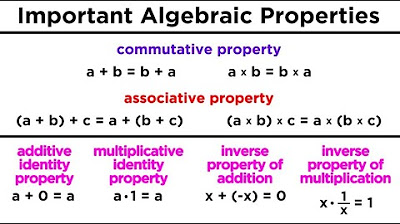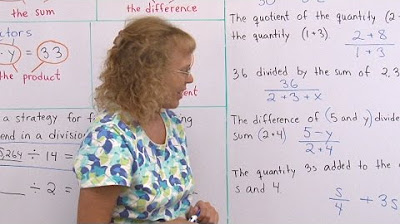Multiplication and Division of Small Numbers
TLDRThe video explains the basic arithmetic operations of addition, subtraction, multiplication, and division. It discusses how multiplication is an abbreviated form of repeated addition and how division does the opposite, breaking down numbers. Key concepts covered include: factors and products in multiplication, dividends, divisors, and quotients in division. It also explains commutative and associative properties and why they apply to multiplication but not division. The video advocates practicing mental math rather than over relying on technology, in order to build mental acuity and appreciate the patterns in numbers.
Takeaways
- 😀 Multiplication is repeated addition, combining identical groups into a product
- 😃 Division breaks down a larger number into smaller pieces based on a divisor
- 🤓 Multiplication and division are inverse operations
- 🧐 Multiplication is commutative and associative, division is not
- 🤔 Memorizing multiplication tables builds mental math skills
- 😕 Overreliance on technology weakens mental math abilities
- 😡 Avoid overusing calculators for trivial math problems
- 🤯 Practice mental math to appreciate patterns in numbers
- 😎 Tips on mental math will be provided later
- 👍 Comprehending the 4 basic operations takes practice
Q & A
How does multiplication relate to repeated addition?
-Multiplication can be viewed as an abbreviated form of repeated addition. For example, 2 x 5 represents adding two, five times, which results in ten.
What are the two numbers that are multiplied called, and what is the result called?
-The two numbers that are multiplied are called factors. The result is called the product.
How does division relate to multiplication?
-Division is the inverse operation of multiplication. If multiplication combines groups into a larger number, division breaks down a larger number into smaller groups.
In division, what are the three key numbers called?
-In division, the number being divided is called the dividend, the number dividing it is called the divisor, and the result is called the quotient.
Is multiplication commutative and associative - why/why not?
-Yes, multiplication is commutative because 2 x 5 = 5 x 2. It is also associative, because the grouping of numbers being multiplied does not change the result.
Is division commutative and associative - why/why not?
-No, division is not commutative nor associative. 10 / 5 / 2 is a different result than 10 / 2 / 5. The order matters in division.
What are some properties of the basic arithmetic operations?
-Properties include: multiplication and addition are commutative and associative, subtraction and division are not. Subtraction/division are the inverse operations of addition/multiplication.
What are some benefits of memorizing multiplication tables?
-Benefits include: faster at mental math, don't need to rely on technology like calculators, improves mental acuity and appreciation of number patterns.
What is the main message regarding use of technology for basic math?
-The over-reliance on technology like phones for basic math is harmful - it reduces mental sharpness and misses the inherent patterns in numbers that mental math reveals.
What can be done going forward to improve mental math skills?
-Practice basic arithmetic operations frequently. Memorize multiplication tables. Learn techniques for mental math calculations.
Outlines
😀 Understanding Multiplication and Division
This paragraph provides an introduction to multiplication and division operations. It explains how multiplication is an abbreviated form of repeated addition, with factors and a product. Division does the opposite, breaking down a larger number into smaller parts, with a dividend, divisor, and quotient. Key properties like commutativity and associativity are also discussed.
😃 Tips for Mental Math
This closing paragraph recommends practicing mental math instead of relying excessively on calculators. It promises future tips on mental math strategies. It then prompts readers to self-check their comprehension of the concepts covered.
Mindmap
Keywords
💡multiplication
💡division
💡factors
💡quotient
💡commutative
💡associative
💡arithmetic
💡properties
💡memorize
💡patterns
Highlights
Multiplication can be viewed as an abbreviated form of repeated addition
Multiplication solves the problem of combining identical groups into a single larger number called the product
Division does the opposite of multiplication by breaking down a larger number into smaller ones
In multiplication, the numbers are called factors and the result is called the product
In division, the number being divided is the dividend, the number dividing is the divisor, and the result is the quotient
Multiplication is commutative - order of factors does not matter
Division is not commutative - order of division changes the result
Multiplication is associative - grouping of factors does not affect result
Division is not associative - order of successive divisions affects result
Memorizing multiplication tables improves mental math skills
Overreliance on technology weakens mental math abilities
Patterns are inherent in numbers
Addition, subtraction, multiplication and division are the four basic arithmetic operations
Understanding properties like commutativity and associativity comes from defining operations and observing
Practice makes math operations easier over time
Transcripts
Browse More Related Video

GED MATH 2024 Preparation Course - from the Absolute Beginning to Advanced Level

Math Videos: How To Learn Basic Arithmetic Fast - Online Tutorial Lessons

Mental Math Tricks - Addition, Subtraction, Multiplication & Division!

Basic Number Properties for Algebra

Math - Decimal Arithmetic

Terminology for the basic operations and writing algebraic expressions from words
5.0 / 5 (0 votes)
Thanks for rating: